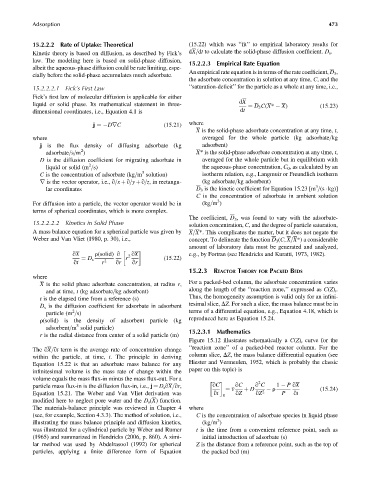Page 518 - Fundamentals of Water Treatment Unit Processes : Physical, Chemical, and Biological
P. 518
Adsorption 473
15.2.2.2 Rate of Uptake: Theoretical (15.22) which was ‘‘fit’’ to empirical laboratory results for
Kinetic theory is based on diffusion, as described by Fick’s dX=dt to calculate the solid-phase diffusion coefficient. D s .
law. The modeling here is based on solid-phase diffusion, 15.2.2.3 Empirical Rate Equation
albeit the aqueous-phase diffusion could be rate limiting, espe-
An empirical rate equation is in terms of the rate coefficient, D 3 ,
cially before the solid-phase accumulates much adsorbate.
the adsorbate concentration in solution at any time, C, and the
15.2.2.2.1 Fick’s First Law ‘‘saturation-deficit’’ for the particle as a whole at any time, i.e.,
Fick’s first law of molecular diffusion is applicable for either
dX
liquid or solid phase. Its mathematical statement in three- ¼ D 3 C(X* X) (15:23)
dimensional coordinates, i.e., Equation 4.1 is dt
j ¼ DrC (15:21) where
X is the solid-phase adsorbate concentration at any time, t,
where averaged for the whole particle (kg adsorbate=kg
j is the flux density of diffusing adsorbate (kg adsorbent)
2
adsorbate=s=m ) X* is the solid-phase adsorbate concentration at any time, t,
D is the diffusion coefficient for migrating adsorbate in averaged for the whole particle but in equilibrium with
2
liquid or solid (m =s) the aqueous-phase concentration, C 0 , as calculated by an
3
C is the concentration of adsorbate (kg=m solution) isotherm relation, e.g., Langmuir or Freundlich isotherm
r is the vector operator, i.e., q=x þ q=y þ q=z, in rectangu- (kg adsorbate=kg adsorbent)
3
lar coordinates D 3 is the kinetic coefficient for Equation 15.23 [m =(s kg)]
C is the concentration of adsorbate in ambient solution
3
For diffusion into a particle, the vector operator would be in (kg=m )
terms of spherical coordinates, which is more complex.
The coefficient, D 3 , was found to vary with the adsorbate-
15.2.2.2.2 Kinetics in Solid Phase solution concentration, C, and the degree of particle saturation,
A mass balance equation for a spherical particle was given by X=X*. This complicates the matter, but it does not negate the
Weber and Van Vliet (1980, p. 30), i.e., concept. To delineate the function D 3 (C, X=X*) a considerable
amount of laboratory data must be generated and analyzed,
qX r(solid) q 2 qX e.g., by Fortran (see Hendricks and Kuratti, 1973, 1982).
¼ D s 2 r (15:22)
qt r qr qr
15.2.3 REACTOR THEORY FOR PACKED BEDS
where
X is the solid phase adsorbate concentration, at radius r, For a packed-bed column, the adsorbate concentration varies
and at time, t (kg adsorbate=kg adsorbent) along the length of the ‘‘reaction zone,’’ expressed as C(Z) t .
t is the elapsed time from a reference (s) Thus, the homogeneity assumption is valid only for an infini-
D s is the diffusion coefficient for adsorbate in adsorbent tesimal slice, DZ. For such a slice, the mass balance must be in
2
particle (m =s) terms of a differential equation, e.g., Equation 4.18, which is
reproduced here as Equation 15.24.
r(solid) is the density of adsorbent particle (kg
3
adsorbent=m solid particle)
15.2.3.1 Mathematics
r is the radial distance from center of a solid particle (m)
Figure 15.12 illustrates schematically a C(Z) t curve for the
‘‘reaction zone’’ of a packed-bed reactor column. For the
The qX=qt term is the average rate of concentration change
column slice, DZ, the mass balance differential equation (see
within the particle, at time, t. The principle in deriving
Hiester and Vermeulen, 1952, which is probably the classic
Equation 15.22 is that an adsorbate mass balance for any
paper on this topic) is
infinitesimal volume is the mass rate of change within the
volume equals the mass flux-in minus the mass flux-out. For a
2
particle mass flux-in is the diffusion flux-in, i.e., j ¼ D s qX=qr, qC qC q C 1 P qX
¼ v þ D r (15:24)
Equation 15.21. The Weber and Van Vliet derivation was qt qZ qZ 2 P qt
0
modified here to neglect pore water and the D s (X) function.
The materials-balance principle was reviewed in Chapter 4 where
(see, for example, Section 4.3.3). The method of solution, i.e., C is the concentration of adsorbate species in liquid phase
3
illustrating the mass balance principle and diffusion kinetics, (kg=m )
was illustrated for a cylindrical particle by Weber and Rumer t is the time from a convenient reference point, such as
(1965) and summarized in Hendricks (2006, p. 860). A simi- initial introduction of adsorbate (s)
lar method was used by Abdelrasool (1992) for spherical Z is the distance from a reference point, such as the top of
particles, applying a finite difference form of Equation the packed bed (m)

